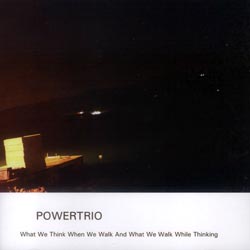
The label "Power Trio" is usually wrapped around the following motif: three scruffy guys with amplified instruments, searching for Heaven in twenty minute solos, or three scruffy guys (three girls if they wear bloody "riot grrl" etchings on their chests) with really amplified instruments, offering immediate three-minute jams. With their fey ensemble of toy piano, harp, classical guitar and electronics, Portugal based Joana Sá, Luís Martins, Eduardo Raon are bent on changing these assumptions with a "narrative based on intensity".
Coming from the "Instant Composition" school (specifically the Franco Evangelisti and Ennio Morricone driven collective, Gruppo di Improvvisazione Nuova Consananza), where notes are recorded to tape, not staff paper, Powertrio navigates through five improvisations, two original works and Gerhard Stäbler's Hart Auf Hart (tough and tough). Beginning with "Ouverture" (sic), the trio delivers its first wallop, a vertical simultaneity of slapped instruments and its residue, a resonant combination of millennial harmonic clusters. The members pause then repeat this act, several times, each blast carrying more weight while violent obstacles gradually find their way into the silent spaces. After the sound of the sky ripping in two, the group settles into a lilting, contemplative mix of hushed pointillism, Raon ending the set with a veiled electronic darkness of twilit field recordings. On the title piece, the trio pursues a similar trail of staccato attack/pensive openness, Raon and Martins offering similar nervous arpeggio patterns on harp and guitar, respectively, as Sá strums and creaks her piano's sound-board. Just before the meanders wear thin, the work unfolds into an alien sound-scape, an accompaniment of reflections from the previous performance alongside a lone, mysterious plucking string, unnaturally low and desperately trying to stay in tune. The first three improvisations, though dressed as nameless interludes, offer insight into the band's amazing ability to construct a single intricate texture whose parts achieve anonymity within the whole, whether gossamer and synthetic ("Improvisation I") or frantic and acoustic ("Improvisation II", "Improvisation III"). The highlight of the album is the reading of Stäbler's red and black barcode-covered graphical score. Inspired by Antonin Artaud, Stäbler's extra-musical instructions suggest a focus on performance/theater space and a rejection of "man and his abilities... broadening to infinity the boundaries of what is usually called reality". Powertrio runs with these options, turning act one into a glitchy toy piano and high register experience, mulching act two into a spooky sine wave détente and bludgeoning the third movement with primal instrument blitzkrieg and near-eviscerating distortion.
Music stands out front of the performers or not, all of these pieces display a universal aesthetic: a dimension of prolonged time, effluent gestures and reverberated shadows held fast by an internal cohesiveness that only comes from an extensive and intimate artistic collaboration shared by its creators.
Comments and Feedback:



More Recent Reviews, Articles, and Interviews @ The Squid's Ear...


|

